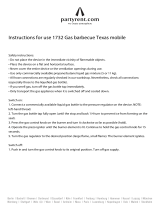
8
The coldest positions in the refrigerator are under the cooling
ns and at the bottom of the refrigerator. The warmer areas
are on the upper door shelves. This should be considered
when placing dierent types of food in the refrigerator.
FROZEN FOOD STORAGE COMPARTMENT
Quick frozen soft fruits and ice cream should be placed in the
coldest part of the compartment, which is at the bottom of
the aluminium liner. Frozen vegetables, may be stored in any
part of the compartment. This compartment is not designed
for deep or quickfreezing of food. Meat or sh, whether raw
or prepared, can be stored in the frozen food storage com-
partment provided they are precooled rst in the refrigerator.
They can be stored about three times longer in the frozen
food compartment as compared to the fresh food compart-
ment. To prevent food from drying out, keep it in covered
dishes, containers, plastic bags or wrapped in aluminium foil.
Ice cubes can be made in the freezer compartment. For faster
ice making, the tray should be placed in direct contact with
the bottom of the freezer compartment. Ice making is acceler-
ated if the thermostat knob B is turned to the “MAX” setting.
It is a good idea to do this a few hours before the anticipated
need for ice, but be sure to turn the thermostat back to normal
setting, usually about mid-setting when the ice is formed.
Food in the lower compartment may be frozen if the setting is
left on “MAX” position.
REMOVING AND REPLACING THE SHELVES
1. Remove the shelf locks by inserting the tip of a at
bladed screwdriver into the slot of the locks. Turn
the screwdriver counterclockwise and then remove
the shelf locks from the wire shelf.
2. Tilt the shelf to one side at an angle while pulling
forward.
3. Reposition the shelf in the desired location. Insert
the ends of the wire shelf on the left-hand side and
slide the shelf into the holes on the right-hand side.
4. Slide the plastic plugs into the holes of the wall.
5. Snap the shelf locks onto the wire shelf.
12 V DC OPERATION
Only operate your refrigerator on 12 V DC when the engine
of the vehicle is running - otherwise your battery will soon be
discharged.
Turn the knob A to the position marked “DC” for
12 V DC operation.
Note that there is no thermostat function on 12 V
DC operation, the refrigerator works continuously.
REGULATING THE TEMPERATURE
The refrigerator is equipped with a thermostat that can be
adjusted by turning the knob B to dierent setting to maintain
the desired cabinet temperature.
ULP gas operation
• At “OFF, the thermostat closes its main valve and the
burner runs continuously at the bypass rate, just enough to
keep the burner lit.
• At “MAX”, the thermostat allows the burner to remain on
high ame continuously.
AC operation (230-240 V AC)
• At “OFF, the contacts in the thermostat are open and the
heating elements are o.
• At “MAX”, the heating element is “ON” continuously.
Lowest cabinet and freezer temperatures are obtained at
this setting.
The thermostat can be adjusted between “MAX” and “OFF”
to obtain the desired cabinet temperature. The closer the knob
is to “MAX” - the colder the cabinet temperature. The closer
the knob is to “OFF” - the warmer the cabinet temperature.
When the thermostat reaches the set temperature, it will cut
the burner back to bypass or, in electric operation (230-
240 V AC), shut o the heating element. The setting of the
thermostat is not critical, but we recommend it be adjusted
to maintain a dry frost on the cooling ns. Adjust the ther-
mostat knob closer to “MAX” when the outside temperature
becomes warm.
TURNING OFF THE REFRIGERATOR
To shut o the refrigerator turn the knob A to
“OFF”.
If the refrigerator will not be in operation for a period of
weeks, it should be emptied, defrosted, cleaned and the door
left ajar. Use the travel catch to hold in this position. The ice
tray should also be dried and kept outside the cabinet.
STORAGE COMPARTMENTS
FOOD STORAGE COMPARTMENT
The food storage compartment is completely closed and
unventilated, which is necessary to maintain the required low
temperature for food storage. Consequently, foods having
a strong odour or those that absorb odours easily should be
covered. Vegetables, salads etc. should be covered to retain
their crispness.
!WARNING
Whilst mobile:
- Do not operate the refrigerator on ULP gas.
- Turn o the gas bottle.
!WARNING
Do not store explosive substances in the refrigerator,
such as cigarette lighter gas, gasoline, ether or the like.












